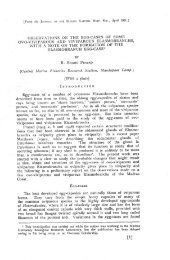PDF - Eprints@CMFRI
PDF - Eprints@CMFRI
PDF - Eprints@CMFRI
You also want an ePaper? Increase the reach of your titles
YUMPU automatically turns print PDFs into web optimized ePapers that Google loves.
85<br />
Material :<br />
Gulf of Suez:<br />
Gulf of Aqaba:<br />
Northern R. S.:<br />
Jerus. SLR<br />
T. Aviv NS<br />
Jerus. SLR<br />
T . Aviv<br />
HLM<br />
T . Aviv<br />
USNM<br />
HLM<br />
NS<br />
EC<br />
NS<br />
Wa<br />
EC<br />
2250- 1- 8 (Ras el Misalla); 827, 2103- 1, 2 (Et T ur).<br />
8434, 8441 , 8442 (Ras Matarma); 8191 (Ras el Kanisa) .<br />
1253 (Fara'un Isl. ); 395 - 6 , 11 (Marsa Murach); 1181 (Marsa el<br />
Muqeibla) ; 454 (EI Kura); 662-1,2 (Marsa Abu Zabad).<br />
9291, 9292 , 9293 , 9298 (Eilat).<br />
453 (Eilat).<br />
1862 (Ras Muhammad).<br />
36 , 37 , 38, 39, 40, 41 , 42 (juv.), 42a (G hardaqa).<br />
472 (Ras Abu Suma); 6 3 ( Koseir, duplicate from KLU NZINGER );<br />
295 (Ras Abu Hagar).<br />
18 (Sanganeb R.).<br />
Central R. S.: P. Sud. Sa<br />
HLM RJ\1 15 , 73, 11 6 , 122 (Wingate R. ).<br />
Southern R. S.: HLM X2 : 9-4,9- 16, 9- 21,9- 25 (Sarso Isl.).<br />
EC 364 (Massawa).<br />
D is t rib uti 0 n : Red Sea; Somaliland (G RA V I ER, 1911); East Africa ; Seychelles; Chagos ; Maldives;<br />
Minicoy; Andaman and icobar IsIs. ; Singapore; Java ; Timor; Banda; Amboina; Ph ilippines; Japan; Palau<br />
IsIs. ; Caroline IsIs .; Great Barrier Reef; Solomon IsIs .; Marshall IsIs. ; Samoa; Tuamotu Archipelago.<br />
Rem ark s : FORSKAL (1775: 134) mentioned a further specimen, different from Madrepora fungites,<br />
one foot long and 5 inches broad, with large lamellar teeth. CROSSLAND (1941 : 40) opined that this<br />
could only be Herpolitha limax. However, we believe that FORSKAL had Ctenaetis eehinata at hand,<br />
which occurs in the Red Sea more fr equently than H. limax.<br />
Additional rem ark s to genus Fungia :<br />
GARDINER (1909 : 278) reported on four specimens of Fungiaacutidens STUDER, collected by CROSS<br />
LAND in the reefs of Suakin . We could not examine these specimens, therefore we mention this species,<br />
previously kn own solely from New Ireland and doubtfully from Tahiti, o nly in an appendi x.<br />
CROSSLAND (J 952) mentioned the occurrence of F. paumotensis STUTCHBURY in the Red Sea. His<br />
own specimen does not come from there and it is , after his own words, an abnormal specimen. We believe<br />
that CROSSLAND 's note depend on a misunderstanding. Also VERON & PI CHO • (J 980) report on F. paumotensis<br />
from the Red Sea. We do not know ro which authority they refer, no other aut hor has ever<br />
published F. paumotensis from the Red Sea. The next locality, where F. paumotensis was found, is<br />
Aldabra (ROSEN, 1971 ).<br />
Genus Ctenaetis VERRI LL, 1864<br />
Ty pes pee i men : Madrepora eehinata PALLAS, 1766.<br />
G e n e ric c h a rae t e r s : Corallum elongate with a long, mono- ro polystomatous axial furrow.<br />
Septa unequal in height with coarse, elongate-compressed, large, spinose teeth. Costae reduced, unequal,<br />
represented by strongly spinose, arborescent spines. The genus is monospecific.<br />
WELLS (1966) has put Fungia eehinata into the new subgenus Ctenactis, and he has established a new<br />
genus, Herpetoglossa , homeomorphic with Fungia (Ctenaetis) , with the same septo-costal structures and<br />
containing one species, H. simplex (GARDINER ). The main difference between these two forms consists<br />
in the development of several calicinal centres in the axial furrow of H. simplex. Wells considers Herpetoglossa<br />
as a very recent polysromarous derivative of Fungia (Ctena etis).<br />
But nearly all authors agree, that F. (Ctenactis) eehinata can be polycentric, roo. Already EHR E BERG<br />
(1834 : 274) had the varieties platystoma and polystoma. Then KLUNZINGER (3, 1879 : 66), DOEDER<br />
LEIN (1902 : 104), GARDINER (1909 : 274), ,'vIATTHAI (1924: 42), BOSCHMA (1925: 216),THIEL (1932 :<br />
67 ), CROSSLAND (1952: 15 2) write that septa of opposite sides fuse at the axial fossa and divide it in<br />
secondary centres, at least the tendency for divid ing is present. Also VERON & PICHON (1980: 171)<br />
state that F. eebinata " may have rarely one, very rarely two, secondary centres". It is not applicable to<br />
separa te specimens with null , one or two secondary centres as F. eehinata from those with three and<br />
mo re under the name H. simplex.
















